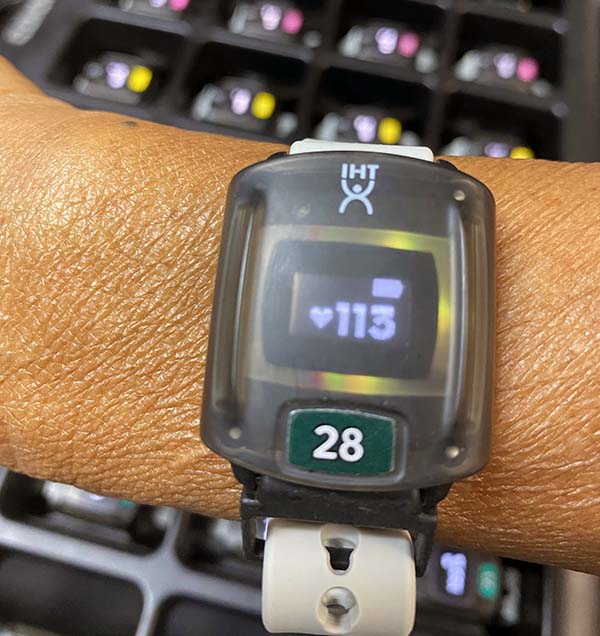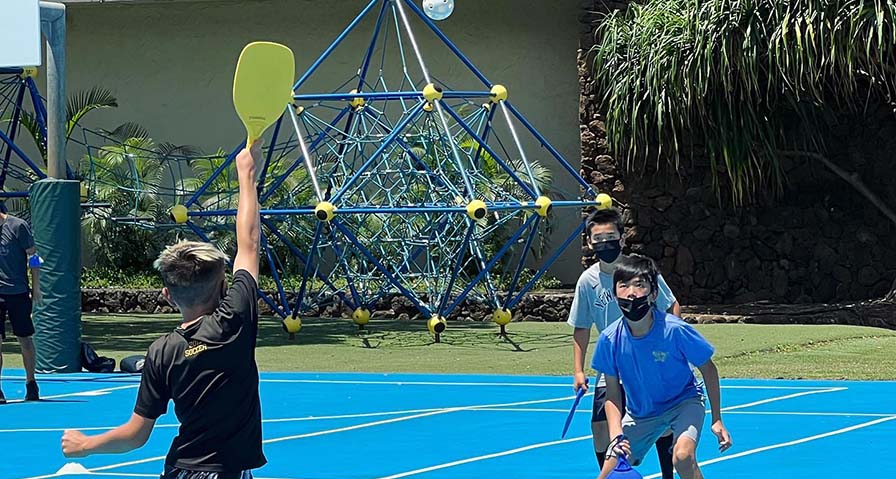High School Students Easily Reflect on Effort Using Heart Rate Charts, Other Personalized Feedback Delivered Directly After Class
Students at Hawaii’s largest independent school wear IHT ZONE heart rate monitors during physical education classes to improve their understanding of how exercise intensity contributes to their overall fitness levels.
“I want them to get a sense of how hard they’re working and how it feels when they’re in really good shape at the end of the semester,” Punahou School Physical Education teacher Shelley Fey said.
 Fey, who’s retiring at the end of the school year, has used heart rate monitors in her high school PE program for years. Fey began using chest strap monitors two decades ago before transitioning to wrist-based monitors to provide her PE students with the same high-level education that they received in their academic classrooms of the prestigious school.
Fey, who’s retiring at the end of the school year, has used heart rate monitors in her high school PE program for years. Fey began using chest strap monitors two decades ago before transitioning to wrist-based monitors to provide her PE students with the same high-level education that they received in their academic classrooms of the prestigious school.
“We feel like we should be offering our students the best experience that we can,” Fey said. “And for me it was utilizing some pretty objective data to give students some feedback about their health and wellness. That’s why I really believe in heart rate monitors.”
Finding the Best Heart Rate Monitor for Her Students
Several years ago, Fey learned the heart rate monitor she’d been using with her students would no longer be available. She took the opportunity to evaluate several other monitors, including the IHT ZONE. With the previous monitor, Fey liked the data but disliked the time it took to download it.
“Up until then, our freshman class was using heart rate monitors for certain activities,” Fey said. “We were able to download the information and get it out to students, but it took hours of downloading. Only a few of us were willing to spend the time doing that.”
In comparing the IHT ZONE to two other brands in 2021, Fey noticed one big difference immediately: the length of time it took to download data from the heart rate monitors.
“After meeting with each (company) and testing, we went with IHT,” she said. “The reason was that it was simple. The data, once collected, could be distributed to students immediately. They would get that feedback and I wouldn’t have to do anything except press that button.”
How simple is the IHT ZONE to use during class? Extremely simple. The IHT Spirit Desktop application allows teachers to get students moving quickly:
- Students pick up their IHT ZONE monitors at the beginning of class, activating them using an NFC reader connected to Fey’s computer.
- The IHT ZONE collects data wherever the student goes while providing a real-time display of heart rate and heart rate zone.
- Students return their IHT ZONE monitors at the end of class using the same NFC reader to download the data collected into the teacher’s IHT Spirit System account.
Once the data downloads, Fey goes to work. As each student returns the monitor, Fey takes a quick opportunity to review data and ask how the student feels. Once all the students return their monitors, Fey closes class by clicking the “save data and close” button on her computer. That immediately sends out summary emails to each student. The summary email includes a heart rate graph of their entire workout and key data points such as total minutes spent exercising and minutes spent exercising in each heart rate zone:
- Blue indicates low-intensity or resting;
- Yellow indicates moderate intensity
- Red indicates vigorous activity
Students Connecting Feeling to Fitness
“We aren’t looking to put major pressure on the kids to achieve,” Fey said. “I just want them to see what is happening with their bodies when they are exercising and have them notice the differences in the activities we do. We focus a lot on individual fitness, so we use the printouts (of the heart rate graphs).”
Students use the printouts – and the emails they receive – to complete secondary assignments based on the workout. Fey’s homework assignment includes several questions, one of which is “what do you notice from your use of the heart rate monitors?”
The data enables students to verify their perceived exertion level and connect how they feel physically, both during and following the class session. Their understanding comes through in both their journal assignments and the conversations they have in class.
Fey shared one student’s reflection:
“I have learned how hard I’m working during class, and I can gauge how much I need to adjust to be closer to the target zones. It helps me adjust my intensity level and see where I’m at during class. I have learned that I am mostly in the yellow zone, and some in the red. That means that I’m working relatively hard during class, and I’m staying at a constant heart rate range.”
That’s the feedback Fey enjoys reading. It confirms that students understand the data and how they are managing their fitness during their 55-minute workouts.
“We talked about how over time your heart and your lungs are working more efficiently,” Fey said, “and therefore you don’t feel as tired. You can last a little longer and they were responding in that way. They noticed that at the very beginning their heart rates were pretty high and as time went on their heart rates weren’t racing as high. They found that they could manage their energy level in their activities a lot better, and they could last longer. And so, they could perform the skills better.”
Fey wants students to understand how to work to improve their cardiovascular fitness and overall health.
“We encourage our students to be active outside of school,” Fey said. “We want them to find things that they enjoy doing and to keep track of it because that’s how we learn. When we write things down, we are able to follow through with what we are intending to do.”
The emails with heart rate data that students receive after each class serve as a visual accomplishment for the day, and the journal assignment reinforces that by having students write about how they felt.
“The printout is kind of the revelation of what their hard work looks like, and then they correlate that feeling like they can play harder, longer,” Fey said.
Passing the Torch
While Fey’s teaching career draws to a close, she wants to be sure that Punahou’s students continue to utilize – and learn from — the heart rate monitors. She and her colleagues worked diligently to rethink their program following COVID, and everyone will benefit from continuing to improve what they built beginning with the 2021-22 school year.
“We had to learn new things including how to use this heart rate monitor,” Fey said. “The teachers here are ready to keep using them and to keep applying what we’ve learned with our students.”
Empowering students to take ownership of their fitness journey remains Fey’s ultimate objective, and she remains confident that the IHT ZONE will help students reach it.
“We just want the students to be active,” she said. “That’s the bottom line. And that heart rate monitor is going to help them each time they show up. They put that one and they are good (to learn). They’re held to task just by putting it on.”
Boost Student Wellness with the Spirit heart rate monitor


